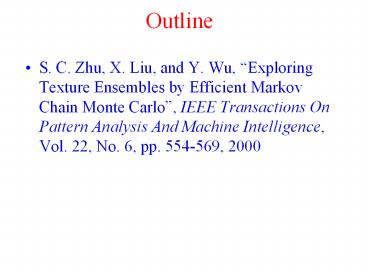Outline - PowerPoint PPT Presentation
Title:
Outline
Description:
Outline S. C. Zhu, X. Liu, and Y. Wu, Exploring Texture Ensembles by Efficient Markov Chain Monte Carlo , IEEE Transactions On Pattern Analysis And Machine ... – PowerPoint PPT presentation
Number of Views:97
Avg rating:3.0/5.0
Title: Outline
1
Outline
- S. C. Zhu, X. Liu, and Y. Wu, Exploring Texture
Ensembles by Efficient Markov Chain Monte Carlo,
IEEE Transactions On Pattern Analysis And Machine
Intelligence, Vol. 22, No. 6, pp. 554-569, 2000
2
Limitations of Linear Representations
- Linear representations do not depend on the
spatial relationships among pixels - For example, if we shuffle the pixels and
corresponding representations, then the
classification results will remain the same - But in images spatial relationships are important
3
Image Features
4
Spectral Representation of Images
- Spectral histogram
- Given a bank of filters F(a), a 1, , K, a
spectral histogram is defined as the marginal
distribution of filter responses
5
Spectral Representation of Images - continued
- An example of spectral histogram
6
Image Modeling - continued
- Given observed feature statistics H(a)obs, we
associate an energy with any image I as - Then the corresponding Gibbs distribution is
- The q(I) can be sampled using a Gibbs sampler or
other Markov chain Monte-Carlo algorithms
7
Image Modeling - continued
- Image Synthesis Algorithm
- Compute Hobs from an observed texture image
- Initialize Isyn as any image, and T as T0
- Repeat
- Randomly pick a pixel v in Isyn
- Calculate the conditional probability q(Isyn(v)
Isyn(-v)) - Choose new Isyn(v) under q(Isyn(v) Isyn(-v))
- Reduce T gradually
- Until E(I) lt e
8
A Texture Synthesis Example
Observed image
Initial synthesized image
9
A Texture Synthesis Example
- Energy and conditional probability of the marked
pixel
10
A Texture Synthesis Example - continued
- A white noise image was transformed to a
perceptually similar texture by matching the
spectral histogram
11
A Texture Synthesis Example - continued
- Synthesized images from different initial
conditions
12
Texture Synthesis Examples - continued
- A random texture image
13
Texture Synthesis Examples - continued
Observed image
Synthesized image
- An image with periodic structures
14
Texture Synthesis Examples - continued
Mud image
Synthesized image
- A mud image with some animal foot prints
15
Texture Synthesis Examples - continued
Observed image
Synthesized image
- A random texture image with elements
16
Texture Synthesis Examples - continued
Observed image
Synthesized image
- An image consisting of two regions
- Note that wrap-around boundary conditions were
used
17
Texture Synthesis Examples - continued
- A cheetah skin image
18
Texture Synthesis Examples - continued
Observed image
Synthesized image
- An image consisting of circles
19
Texture Synthesis Examples - continued
Observed image
Synthesized image
- An image consisting of crosses
20
Texture Synthesis Examples - continued
- A pattern with long-range structures
21
Object Synthesis Examples
- As in texture synthesis, we start from a random
image - In addition, similar object images are used as
boundary conditions in that the corresponding
pixel values are not updated during sampling
process
22
Object Synthesis Examples - continued
23
Object Synthesis Examples - continued
24
Linear Transformations of Images
- Linear transformations include
- Principal component analysis
- Independent component analysis
- Fisher discriminant analysis
- Optimal component analysis
- They have been widely used to reduce dimension of
images for appearance-based recognition
applications - Each image is viewed as a long vector and
projected into a set of bases that have certain
properties
25
Principal Component Analysis
- Defined with respect to a training set such that
the average reconstruction error is minimized
26
Principal Component Analysis - continued
27
Eigen Values of 400 Eigen Vectors
28
Principal Component Analysis - continued
Reconstructed using 50 PCs
Reconstructed using 200 PCs
Original Image
29
Principal Component Analysis - continued
- Is PCA representation a good representation of
images for recognition in that images that have
similar principal representations are similar? - Image generation through sampling
- Roughly speaking, we try to generate images that
have the given coefficients along PCs
30
Principal Component Analysis - continued
31
Principal Component Analysis - continued
32
Difference Between Reconstruction and Sampling
Reconstruction is not sufficient to show the
adequacy of a representation and sampling from
the set of images with same representation is
more informational
33
Object Recognition Experiments
- We compare linear methods in the methods
including - Principal component analysis (PCA)
- Independent component analysis (ICA)
- Fisher discriminant analysis (FDA)
- Random component analysis (RCA)
- For fun and to show the actual gain of using
different bases is relatively small - Corresponding linear methods in the spectral
histogram space including - SPCA, SICA, SFDA, and SRCA
34
COIL Dataset
35
3D Recognition Results
36
Experimental Results - continued
- To further demonstrate the effectiveness of our
method for different types of images, we create a
dataset of combining the texture dataset, face
dataset, and COIL dataset, resulting in a dataset
of 180 categories with 10160 images in total
37
Linear Subspaces of Spectral Representation
38
Experimental Results - continued
- Combined dataset continued
- Not only the recognition rate is very good, but
also it is very reliable and robust, as the
average entropy of the p0(iI) is 0.60 bit (The
corresponding uniform distributions entropy is
7.49 bits)
39
Experimental Results - continued
- Combined dataset continued
- Not only the recognition rate is very good, but
also it is very reliable and robust, as the
average entropy of the p0(iI) is 0.60 bit (The
corresponding uniform distributions entropy is
7.49 bits)

























![[READ]⚡PDF✔ Black Letter Outline on Contracts (Black Letter Outlines) 5th Edition PowerPoint PPT Presentation](https://s3.amazonaws.com/images.powershow.com/10044064.th0.jpg?_=20240531080)


![[PDF] DOWNLOAD FREE Clinical Outline of Oral Pathology: Diagnosis and PowerPoint PPT Presentation](https://s3.amazonaws.com/images.powershow.com/10076578.th0.jpg?_=20240711025)


